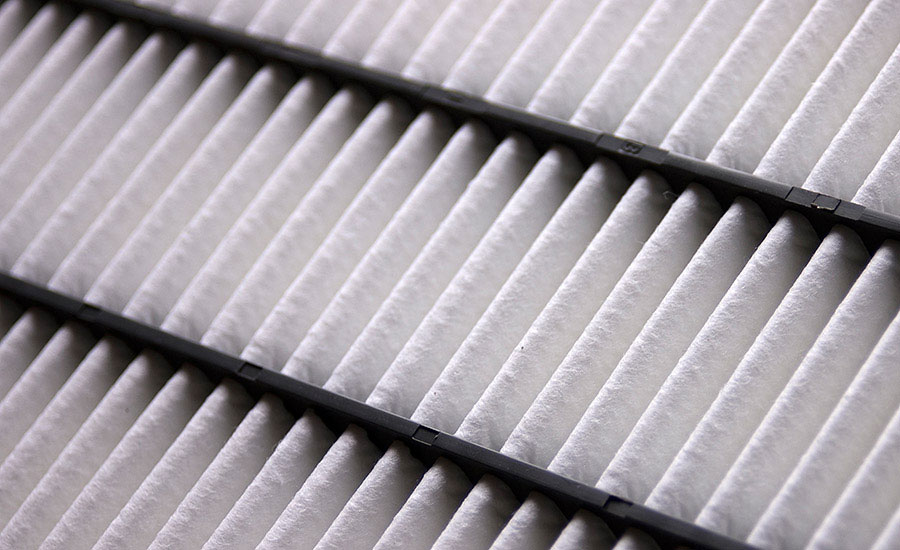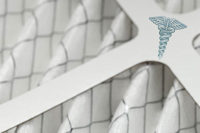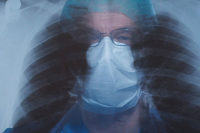Health care acquired infections (HAIs) are infections that patients get while receiving treatment for surgical conditions in a health care setting. HAIs are among the leading causes of preventable deaths in health care environments and are associated with a substantial increase in health care costs each year. They occur in all types of care settings, including acute care within hospitals, ambulatory outpatient care in health care clinics, same-day surgical centers, and residence in long-term care facilities like nursing homes and rehabilitation facilities.
Some causes of HAIs are directly related to professional practice and protocols: the use and maintenance of medical devices, such as catheters and ventilators; complications following surgical procedures; transmission of infectious disease between patients and health care workers; and disproportionate nurse-to-patient ratios. Some causes are related to building design topics, such as the physical layout of the health care facility (e.g., open beds close together) or a contaminated air conditioning system.
While the first group of factors is certainly outside the influence of A/E design professionals, the one factor that is within the realm of control of a mechanical engineer is the HVAC system design. The design of the ventilation system, specifically air change rates per hour, laminar diffuser layout, and the quality and effectiveness of the air filtration system are important factors that affect the HVAC system’s ability to protect against HAIs.
Air filtration is the primary means of reducing concentrations of airborne bacteria that cause HAIs. Studies have shown that 99.9% of airborne bacteria in hospitals are removed by installing a 90% to 95% efficient (MERV 14) filter in the AHUs. ASHRAE Standard 170-2013, Ventilation for Health Care Facilities, requires two levels of filtration for patient care areas. The first filter should be upstream of fans and coils, and the second filter should be downstream of the cooling coils and supply fan. Alarmingly, however, there are still several cases reported each year where operating rooms which comply with these requirements record cases of HAI. Beyond the devastating human toll, these cases also result in sizeable monetary payouts by the health care institution.
ASHRAE Standard 170-2013 requires HEPA filters for protective environments and isolation rooms designed for patients with high susceptibility to infections and patients that can spread communicable diseases. The guidelines do not discuss the use of any additional filtration for any other critical health care environments, such as procedure rooms and operating rooms. Of course, the ASHRAE 170 standard is a minimum requirement and does not prohibit the mechanical engineer from specifying more stringent levels of filtration for air handling unit design. This is where alternate filtration technology can be implemented during the design of the HVAC system to enhance filter efficiency and reduce the occurrence of HAIs.
MERV 14 filters target certain bacteria, mold spores, and pollen and are common and well-suited to typical commercial and residential building systems. But MERV filters provide no airstream protection from certain bacteria, most viruses, fungi, voltaic organic compounds (VOCs), and certain odors. Hospital owners, epidemiologists, facilities managers, and mechanical engineers must be more vigilant in the design and operation of the HVAC system in order to reduce the occurrence of HAIs.
The state reimbursement requirement for hospitals under the Medicaid and Medicare programs was changed on October 1, 2008. The Center for Medicare and Medicaid (CMS) is no longer providing reimbursement over and above the typical Inpatient Prospective Payment System rate. Notably, this includes care required to battle several types of health care-associated infections, two of which are directly related to potential surgical site infections: mediastinitis (inflammation of tissues in the mid chest) after a coronary artery bypass graft and an array of infections resulting from certain orthopedic and bariatric surgeries.
Beyond the obvious professional goal of all health care workers to “do no harm,” there is a strong financial incentive to avoid HAIs. As an avoidable complication, cost to treat these secondary infections will not be reimbursed through government programs.
Clearly, facilities engineers and mechanical designers must do their part to assist the health care facility in ensuring that the HVAC system is properly safeguarded against HAIs. Mechanical engineers need to explore the use of enhanced filtration technology to supplement the code required filtration levels in the HVAC system, such as HEPA, UV lights, and catalytic air cleaners.
HEPA Filtration
HEPA filters are a form of extended surface media air filters previously known as high-efficiency particulate arrestors. A “true” HEPA filter must be at least 99.997% efficient, allowing no more than three particles in 10,000 to penetrate the filtration media. ASHRAE 170, Ventilation for Health Care Facilities, states that HEPA filtration is only mandatory for protective environment and isolation room HVAC systems.
Using HEPA filtration in the design of all critical health care spaces is the best method to help hospitals safeguard their HVAC system against HAIs caused by poor air quality. This will help the health care systems to respond to the new state of reimbursement. HEPA filtration should be mandatory for inpatient surgery suites, procedure rooms, outpatient surgery suites, labor and delivery departments, bone marrow transplant, isolation rooms, critical care, and intensive care.
The HEPA filter provides the best protection from infection and contamination by airborne microorganisms, especially when engineered so that the filter is mounted at the terminal of the duct, commonly referred to as ceiling-mounted HEPA filters or modules. Locating HEPA filters in AHUs is not as effective, especially for surgery suites. A recent study has shown that a special type of HEPA air purifier, known as a PAS-HEPA (portable anteroom system HEPA) filter unit, can dramatically lessen the presence of infectious particles in the air, protecting health care professionals and patients alike.
A study was conducted by Russell M. Olmstead, an epidemiologist who works for Saint Joseph Mercy Hospital in Ann Arbor, MI. The study tested the effectiveness of PAS-HEPA filter units that were installed above the door leading into an operating room. While standard HEPA air purifiers have been used for some time within many operating rooms, he wanted to see the effects of the newer technology on airborne particulates like those associated with tuberculosis. Smoke and particulates that were very similar in size and consistency to those associated with TB were used during the study. The study proved that the PAS-HEPA filter units effectively pulled target particles down and away from the operating room table, the most critical area in the room. This enhanced PAS-HEPA filtration design could be applied to many other critical hospital spaces to reduce the occurrence of HAIs.
Ultraviolet Technology
Ultraviolet germicidal irradiation (UVGI) technology is used to inhibit microbial growth and limit transfer of infections in hospitals. UVC fixtures are a subset of UV lights that are used for germicidal irradiation. The ASHRAE 170 standard does not address the use of ultraviolet radiation lights inside of AHUs or in the surgery space as a means for killing pathogens; however, some studies have shown that these devices can be effective in preventing microbial growth.
UVC lights can be utilized to inhibit microbial growth and transfer in hospitals through installation in HVAC systems and standalone fixtures as follows.
• Cooling coil disinfection — installation of UVC fixtures for direct irradiation of the cooling coils
• Surface sterilization with direct UVC fixtures
• UVC for operating rooms — a unique combination of air and surface sterilization systems specifically designed for operating rooms
• Air disinfection — installation of in-duct UVC air cleaners for air stream irradiation; additional in-room UVC fixtures can be used for upper air disinfection
UVC air purification and surface sterilization differ only in the amount of time the microorganisms are exposed to UVC radiation. In moving airstreams, microorganisms are traveling at fast speeds and therefore may be exposed for only a fraction of a second. Because of this, it is important to apply more UVC energy with high-output UVC lamps to get the disinfection desired.
With surface sterilization, there is an almost unlimited residence time; therefore, less UVC intensity is necessary. The dose needed for effective sterilization is a function of UVC intensity, time, and distance from the surface.
During design, mechanical engineers can develop specialized UVC solutions for operating rooms to increase the air filtration effectiveness. This will create a more sterile environment which is very important for preventing complications during organ transplantation or open joint surgical procedures. Achieving and maintaining a sterile environment in operating rooms is crucial for patients with weak immune systems, due to cancer or AIDS. Operating room UVC sterilization packages combine all implementations of the germicidal UV technology to ensure a clean environment.
Operating room UVC sterilization can be achieved with two distinct processes. First, the room is entirely irradiated with UVC fixtures before it is occupied. This will sterilize all the surfaces exposed to the UV rays. These fixtures will be turned off during occupancy. Second, the air within the operating suite is irradiated with indirect germicidal fixtures; this serves to stop the transfer of microorganism and other pathogen through the air. These indirect fixtures will stay on for the duration of the surgical procedures.
Another level of protection can be added by using germicidal UV door barriers that prevent harmful pathogens from entering the sterile operating room environment from outside the operating zone where the level of sterility is not as high. Germicidal UV lights can be used in all critical areas of the hospital to inhibit microbial growth and prevent mold growth.
Catalytic Air Cleaners (CAC)
Catalytic air cleaning is the process of using photo catalytic oxidation to remove odors, fungi, bacteria, and some viruses from the air steam. Photo catalytic oxidation (PCO) is the process of using ultraviolet (UV) photons to energize a photo-catalyst media panel, creating highly reactive radicals. Hydro-radicals convert organic compounds into simpler compounds and ultimately into carbon dioxide and water. The UV radiation penetrates microorganisms such as bacteria, viruses, and fungi, and it damages their DNA structure.
CAC can be useful for hospital waiting rooms, operating rooms, procedure rooms, and other occupied areas to reduce airborne disease that is often spread in the health care environments. It is important to note that this filtration system is very effective when used in the filter bank of AHUs and is used in conjunction with the levels of filtration recommended by ASHRAE 170. These filters add a premium to the AHU’s cost and should be discussed upfront with the owners before it is included in the design.
AHUs can vary in design from one hospital to another and especially between different manufacturers. Due to budget constraints, the use of large central station units with multiple fans for hospitals are on the rise due to efficiencies of scale. For some community hospitals, these large central station air handling units even serve the operating rooms as well as other spaces in the hospital. This makes the installation of CAC much more attractive because it is cheaper and will also provide a better air quality throughout the whole facility. The cost is less because less CAC is required when there are only a few AHUs used for the hospital.
For more specialized hospitals, such as acute care hospitals, multiple AHUs are used to serve the hospital to provide better control of the airflow to the space and more reliable HVAC systems. Special considerations should be given to air filtration for critical spaces such as operating rooms; these spaces should include CAC in the design of the AHUs. Due to cost constraints, the mechanical designers will need to advise the hospital owners on the most appropriate areas for CAC inclusion in AHUs. If the hospital owners are very concerned about good air quality and HAI reduction, then CAC should be specified for all the AHUs in the hospital.
Conclusion
There is no question that IAQ is important in the health care environment. In reality, a proper indoor environment is crucial to patient recovery and to minimize the occurrence of health care acquired infections. Mechanical engineers should be concerned about more than comfortable indoor temperature. Mechanical engineers need to understand what enhanced filter technologies are available and how to apply them to the design of the HVAC system. This will help the health care facility to protect patients from infection and to reduce the risk of costly litigation and business interruption. Also, owners need to invest in the use of enhanced air filtration for air distribution systems in their facility because it will improve the indoor environment and reduce the impact of HAIs on their facility. ES
Garold “Gary” Hamilton is a Principal and the National health care engineering lead and a Project Manager for SmithgroupJJR, one of the nation’s largest architecture, engineering, and planning firms. He is a licensed professional engineer in the U.S.A. as well as in Europe. He has over 18 years of experience in the design and analysis of heating, ventilating, and air-conditioning systems for a variety of market sectors, but with special focus on health care facilities. He is a LEED AP and has designed over 17 projects that achieved LEED certified status. He is also a certified commissioning authority with the AAB Commissioning Group (ACG). He is an active member of American Society of Healthcare Engineering (ASHE) and is an ASHE volunteer with responsibility in assisting ASHE with providing peer support and assisting in special projects. He is a member of the ASHE Editorial Advisory Board and was just named a Senior of ASHE. His major clients include Trinity Health/Holy Cross Hospital, Highland Community Hospital; Hattiesburg Clinic, Kaiser Permanente, Unity Health care; the NAVFAC, VA Hospitals; Carilion Clinic, and the University of Virginia Health System.





